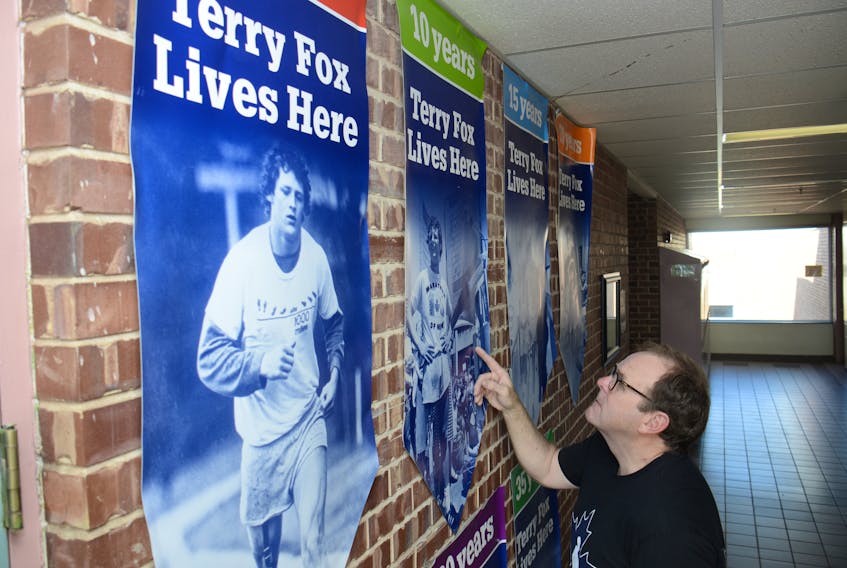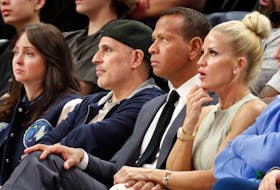Gordie Cox watched intently as the young man ran along the highway in New Haven with a distinct hop and skip combination on a Sunday morning 40 years ago today.
“At the time he was Terry Fox, but he wasn’t Terry Fox,” Cox said.
“He was the guy who was going to run by Fairyland and he’s raising money for the cancer society.”

Fox wasn’t the legend he would later become when he arrived on Prince Edward Island on May 24, 1980, via the ferry from Cape Tormentine, N.B., to Borden.
The 21-year-old from Port Coquitlam, B.C., had started the Marathon of Hope by dipping his artificial right leg into the Atlantic Ocean in St. John’s, N.L., on April 12. Raising money for cancer research and bringing awareness about the disease to the forefront, Fox made his way through Newfoundland, Nova Scotia and southeast New Brunswick before catching the ferry to the Island.
Cox’s father, Jim, was the executive director of the local branch of the Canadian Cancer Society in 1980 and helped set up events for Fox while he was on the Island.
Cox was in Grade 10, not much younger than Fox. He remembers asking his father if he could tag along with him that Sunday morning. He recalled seeing an amputee wasn’t common and one doing a marathon a day crossing the country was unheard of.
“It was really aspiring.”
Cox stood an estimated 30 feet back from the road and observed intently.
“I remember him going by and I watched him, and he had that shuffle,” he said.
“He didn’t stop. He just waved at everybody and everybody clapped, and he just kept motoring by.”
On the way home, Cox asked his father questions about the marathon and Fox.
“Back in 1980, you didn’t have the internet, you didn’t have cellphones and you couldn’t Google it,” he said.

Timeline
- March 9, 1977 Terry Fox discovers a malignant tumour in his right leg. It is amputated 15 centimetres above the knee. The night before the surgery Fox reads about an amputee runner and dreams of running.
- February 1979 Fox begins training for a cross-Canada run to raise money for cancer research and awareness.
- April 12, 1980 Fox began his Marathon of Hope in St. John’s, N.L.
- May 24, 1980 Fox takes the 2:30 p.m. CN ferry across the Northumberland Strait from Cape Tormentine, N.B., to Borden. He ran 4.25 miles into Borden after getting off the ferry. He met local officials from the Canadian Cancer Society there. He watched part of Game 6 of a Stanley Cup playoff series between Philadelphia and the New York Islanders. “It is beautiful country,” he wrote in his diary, published in Terry Fox: His Story by Leslie Scrivener.
- May 25, 1980 Fox runs from Summerside to Charlottetown. “In terms of sun, weather, and terrain this was the most beautiful day so far,” he wrote in the diary. “There were lots of people out to cheer me on and support me. Incredible! We collected over $600 on the road today, our best.”
- May 26, 1980 Fox meets with officials at Charlottetown city hall and Premier Angus MacLean. He also stopped to talk with students at Eliot River Elementary School in Cornwall. “Boy, were they ever a happy group,” he wrote in the diary. “Many people are congratulating me and I can’t figure out what for.”
- May 28, 1980 Fox was in Moncton.
- Sept. 1, 1980 Fox stops running outside of Thunder Bay, Ont., after 143 days and 5,373 kilometres when the cancer spread to his lungs. He returned home to British Columbia for treatment.
- Sept. 9, 1980 CTV organizes a five-hour telethon that raises $10 million.
- Feb. 1, 1981 Fox’s goal of raising $1 for every Canadian is realized. The population was 24.1 million and the Terry Fox Marathon of Hope reaches $24.17 million.
- June 28, 1981 After chemotherapy and interferon, Fox dies in a New Westminster, B.C., hospital.
- Sept. 13, 1981 The first Terry Fox Run is held at more than 760 locations around the world. 300,000 people participated, raising $3.5 million.
Growing story
Fox's journey was covered by local media as he completed each lap.
Wayne Young was early in his journalism career when he was assigned to catch up with Fox the same Sunday morning. The assignment didn’t stand out initially, but that changed quickly.
“All of a sudden you realize this guy has come from Newfoundland across the Maritimes on his way to B.C. on one leg,” he said.
“You’re just in awe of what he’s doing.”

Young, who was 20 at the time, had left his Summerside home and expected to catch up with Fox as he made his way towards Charlottetown.
“I’m driving and driving and there’s no sign of him,” Young recalled.
“I thought, ‘Did I miss him’?”
The intrepid reporter kept driving and then noticed the van trailing behind the runner in Tryon. He snapped a few photos with his film camera, long before digital photography was the norm, as Fox kept running. He stopped for an interview in Hampton.
“He was good and took the time to answer the questions,” Young said.
“I think I really understood then that this guy was for real – he was something special.”
What initially struct Young was the running style Fox employed. The reporter described it as a double hop on his artificial leg and a long step on his good leg. Fox had run 12 miles before 9 a.m. on an overcast day. It later rained and Fox took a two-hour break and waited for it to pass.
Young’s story appeared in Monday’s edition of The Guardian on Page A3 back then.
“It wasn’t the story that it became at the time,” Young said.
“It grew and grew and grew.”
Lasting impression
Fox met with dignitaries in Charlottetown on Monday, May 26, and stopped at Eliot River Elementary School in Cornwall to talk to the 700 students.
“To tell you the truth, we didn't know an awful lot about (his presentation),” principal Gordon MacInnis said.
“When he started out early on ... there wasn’t a whole lot of press or any great organization to their little entourage.”
He recalled students being mesmerized by the unique way Fox was able to move and what he was trying to achieve. Bill Hogg, who was the school’s librarian at the time, agreed.
“It was the first time that many of these children had seen, one, an amputee, and two, an amputee that was attempting something that was just beyond imagination — he was going to run across our country,” he said.
“It was an electric moment for the entire student body. It was pretty exciting.”
Lee Drake was one of the students at the school that day. He was asked by MacInnis to greet Fox at the front door and help escort him to the gym for the assembly.
“Even at our young age, we knew that he was very young. He just had this humble way of really connecting with students and telling his story,” said Drake, who was 11 years old at the time.
“I think from that moment on … we were all cheering for him,” he added.
“He had such an effect on me that day … I set up a (donation) box at the local (grocery) store, which was owned by Danny Gass at the time.”
Fox’s story grew significantly as he entered central Canada, but the run was halted in September in Thunder Bay, Ont., when the cancer spread to his lungs.
He died on June 28, 1981.
“I can remember that day when he had to give up and stop,” Hogg said.
“It was tragic. We had made a connection with this young man who had such a charisma about him. There was a definite magnetism to Terry. … He was an amazing human being.”
Leaving a legacy
Thirty years after Fox visited the Island, Drake was the MC as the Town of Cornwall officially opened the Terry Fox Sports Complex during a ceremony in the school’s gymnasium. Fox’s parents, Betty and Rolly, made the trip to the Island to participate in the ceremony a day before about 10,000 people ran across the Confederation Bridge as part of the 30th anniversary of the Terry Fox Run.
Cox later became a teacher and joined Coloney Gray High School 25 years ago. He has been a faculty adviser for the school’s Terry Fox Walk/Run for about a decade.
The school has a wall dedicated to Fox with a rare flag, posters and a photo of the student body in the shape of a heart plus his initials. Colonel Gray has raised the most money of any Primary-to-12 school in Prince Edward Island and New Brunswick during the past 10 years. Cox estimated the figure was about $115,000 during the decade.

“We’re pretty proud of that at Colonel Gray,” said Cox, one of the school’s counsellors.
The student body has changed during the past few years. There are now 300 teenagers from 58 countries and 33 different languages are spoken by the students.
Cox goes to each class annually to talk about Fox and why they have a run.
“It really does the heart well when I drive around and see kids representing all of these different countries participating in the Terry Fox Run,” he said.
“I think his legacy deserves to be remembered.”

Terry Fox has given people hope
Terry Fox was a lot of things to a lot of people, but Fred Fox knew him as his brother.
He goes to schools and shows a Powerpoint presentation loaded with family photos and shares stories about what Terry was like at their age.

Many of the youth know about Terry and view him as a hero. Fred said Terry saw himself as ordinary kid with average abilities.
“I’d just echo what Terry would say,” Fred said.
“He wasn’t all that good at sports, he wasn’t the best student in class, but it was his hard work and never-give-up attitude and all the other characteristics that he had (plus) the work ethic our parents had taught him that allowed Terry to do what he did.”
And while Terry started the Marathon of Hope to find a cure for cancer, another big component was to raise awareness of the disease.
“We didn't know anything about cancer, Terry and I,” said Fred, who was 14 months older than Terry.
“Mom used to say people would refer to cancer as the C word and they wouldn’t talk about it.”
His brother wanted to create hope and that’s what he has done.
“All these years later, sure, that ultimate cure hasn't been found but the money has done miracles for so many people,” Fred said, noting people are living longer and with a better quality of life after a diagnosis.
“Terry would be so proud of what Canadians have done in the fundraising and what researchers have done in Canada to give people hope.”
The Terry Fox Run is held in 30 countries and 3 million students will participate in runs at schools this year. About $780 million has been raised in Terry’s name for cancer research.
“Terry shied away from any recognition. He didn't want to be called a hero, he didn't see himself as a hero, he was doing it to make a difference in other people’s lives,” Fred said.
Fred said his brother’s story sees a bump during anniversary years. Earlier this month Adidas Canada announced a limited edition nine-piece collection of Terry Fox merchandise, including the release of the original Orion running shoes, with all net proceeds going to the Terry Fox Foundation. They sold out in minutes.
Fred said, “If not for people across this country, Terry’s legacy wouldn't be what it is today.”









